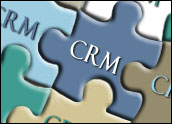
Online retail sales in the U.S. are projected to reach US$156.1 billion in 2009, jumping to over $229.1 billion by 2013 and accounting for 8 percent of total U.S. retail sales, according to a recent report by Forrester.
When e-commerce was born some 13 years ago, systems were typically proprietary, requiring a large team of internal developers to constantly upgrade features while diligently working to integrate them into key legacy back-office systems. At times, these were near-impossible tasks that consumed vast amounts of money and time.
Today, the approach favored in most e-commerce deployments is a more open architecture that allows companies to build out, add features and scale as demand dictates. One area seeing tremendous growth is the convergence of e-commerce with customer relationship management (CRM), especially as the current recession threatens to further eat into traditional sales.
Although economic turbulence has slowed capital expenditures (CAPEX) on new enterprise technology endeavors, investment in e-commerce platforms remains very strong, according to Forrester, with 26 percent of firms planning to buy or upgrade in 2009.
Key Differentiator
By seamlessly converging e-commerce with CRM, companies can focus on enhancing sales through a better churn of existing leads while detecting upsell opportunities with existing customers. For example: Integrate e-commerce and CRM to deliver a better method for flagging preferred customers, for charting purchasing patterns, and for promoting marketing incentives such as discounts based on customer loyalty.
Another example is providing merchants with the ability to log each customer that abandons a cart as an opportunity in CRM — with the value of the opportunity being the value of the abandoned cart. This allows salespersons to try and convert an abandoned online experience into a sale by introducing a personal touch to the relationship.
Whether using a converged e-commerce/CRM system strictly for sales or to enhance customer service, the usability of the CRM system is critical for company-wide adoption, and it can be the key differentiator between success and failure.
Taking the example cited above a step further, an automatic email promotion can be run after the cart has been abandoned with a promotion code that provides a discount percentage on the items in the cart with an expiration date. The combination of a follow-up promotion email with a phone call from a salesperson can do wonders to a merchant’s conversion rate.
The No. 1 Killer
Interestingly, many CRM implementation managers focus entirely on functionality and features when deciding on a new system, and give little regard to actual usability. It turns out that you can incorporate all the cutting-edge CRM features available today, but if your salespeople or customer service representatives don’t enter the data, then it is unlikely your managers will receive actionable reports or any pertinent analytical information that can help with upsell or improve customer service.
The lack of usability is the No. 1 killer of all e-commerce/CRM convergence implementations. Something as trivial as not incorporating integration between CRM and an existing application such as Microsoft Outlook or any other key application — for example, the e-commerce administration panel the sales team uses on a daily basis — may completely ground the new system from day one.
Consider this: Does the CRM system require a separate login? If yes, say “Ouch!” — you just dropped your chances of adoption within the user community by at least 30-to-40 percent. Does the CRM application require an additional window to be opened, or does it work natively in the salesperson’s work environment/current application without an additional login?
The success rate of CRM systems that work natively within popular applications such as MS Outlook or Excel is dramatically different from those that don’t. Adoption in the user base can be 30 percent higher — or more — for systems that work in an integrated environment with a client email system such as Outlook compared to systems that don’t.
Boosting Usability
To ensure that company expenditures on critical systems such as a converged e-commerce/CRM platform achieve optimal return on investment, implementation managers must home in on the needs of the sales team. The following are critical elements to consider:
The converged system must be intuitive and user friendly. Over anything else, people-friendliness is going to make the biggest difference in terms of success or failure. For example, if your sales or customer service teams live in Microsoft Outlook, then asking them to go to a standalone Web interface and log in, enter sales leads or support-incident information, and then re-enter contact data is a recipe for disaster. It would be more practical if they could enter a contact in Outlook that would instantly and seamlessly integrate with the new CRM platform. Simplicity such as this could make the difference, resulting in a successful implementation with a high adoption rate rather than failure.
Ensure the system delivers value to users. If salespersons or customer service representatives are only putting information in and not getting anything out, why would they continue to use it? Make your CRM system your sales team or customer service team’s home, essentially a one-stop shop for all things sales or customer service related. Incorporate all leads into the system, so that CRM becomes the primary way to scout for new business. Or house all marketing campaigns and sales literature inside the system, so if a team member needs a certain presentation, it is quickly available with a few clicks of the mouse. Lastly, integrate workflows and event notices, allowing team members to receive reminders before opportunities close, which will significantly improve sales win ratios.
Incorporate single sign-on features that are tied in with the user login on the computer, avoiding the need for second logins. Multiple logins are anathema to any enterprise platform. If access to the new system is complicated, your team will simply avoid it altogether. A general rule of thumb: Any process for accessing information that requires more than two steps should be re-thought.
Allocate enough training time from the field to the system. More often than not, this critical step is either carried out in an extremely limited fashion or is skipped altogether, resulting in team members quickly labeling the new system “useless.” If a company is committed to spending substantial time and money resources on a new converged e-commerce/CRM platform, it is common sense to want your team properly trained to utilize all the features and provide feedback on how to further improve the system. It’s understandable that most managers would rather keep their teams on the field selling than herd them into classrooms to learn new procedures. To draw a parallel with the airline industry, grounded planes are viewed as money losers. However, managers need to take a long view, understanding that time used to get up to speed will be well spent down the road.
As online operations continue to enjoy exponential growth rates — even in the current recessionary climate — the trend toward converging e-commerce with legacy back-office systems like CRM and ERP as a way to boost sales will likewise grow. Integrating the systems into a singular platform is simply a matter of technical academics; the real work is ensuring that sales and marketing teams actually use it. Managers who pay particular attention to the human element in terms of logic, ease of use and proper training, will see adoption levels — and sales — increase tenfold.
Sandeep Walia is president of Ignify, a provider of e-commerce, CRM and ERP solutions targeting the medium and large enterprise market segments.














































Social CRM
See all Social CRM